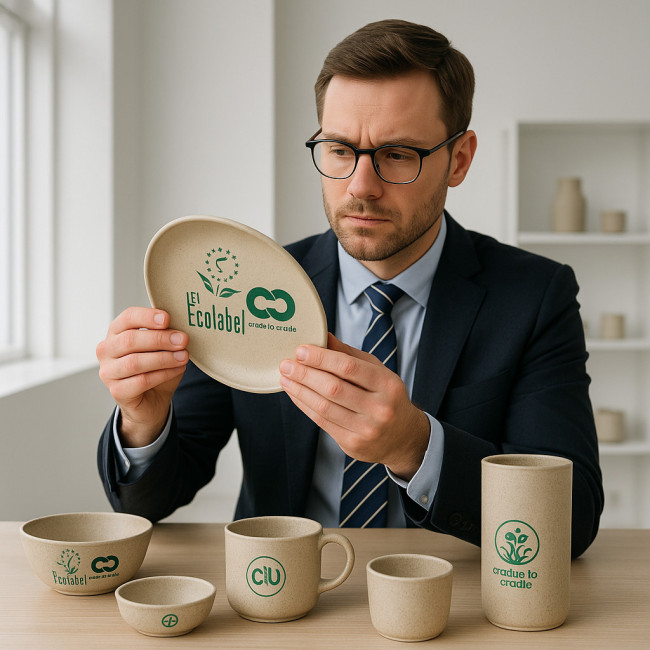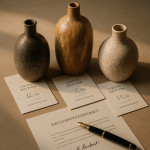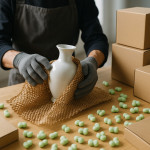Sustainability labels in ceramics: what recruiters must verify before hiring
Hiring a ceramist with a strong eco-profile can boost brand reputation and satisfy corporate ESG targets. Yet not every “green” stamp on tableware or decorative tiles means the same thing. This guide unpacks the most common sustainability labels in ceramics, how they differ, and the exact proofs recruiters must request before signing a contract.
Why sustainability labels matter in the ceramics supply chain
Ceramic production involves clay extraction, high-temperature firing, glazing and global logistics—all stages with environmental impact. Verified eco-labels signal that a studio controls energy use, sources responsibly and limits toxic emissions. Recruiters who understand label criteria can:
- Shortlist suppliers faster and avoid greenwashing scandals.
- Meet client sustainability KPIs without costly audits.
- Unlock larger tenders that require third-party certification.
For example, hospitality groups using locally sourced ceramic collections reduce freight emissions and gain marketing value from verified labels.
The six labels you'll meet most often
| Label | Focus area | Proof needed from the ceramist | Recruiter red flags |
|---|---|---|---|
| Cradle to Cradle Certified® | Material health, circular design, renewable energy | Valid certificate number, product scorecard, renewal date | Certificates older than two years; only “material” certified, not the finished piece |
| EU Ecolabel | Resource efficiency, reduced heavy metals, lifecycle impact | Official licence code starting with “PT/016/...” or similar country prefix | “Inspired by EU Ecolabel” wording without licence code |
| ISO 14001 | Environmental management system | Accredited audit report, scope including kiln operations | Self-issued declarations without third-party auditor name |
| NSF/ANSI 51 | Food-contact safety | NSF certification letter covering glaze composition | Only clay body certified but coloured glazes missing |
| Lead-Safe Certified | Lead content below legal limits | Laboratory test results < 90 ppm (US) or 0.01 % (EU) | Results older than 12 months or from non-accredited labs |
| B Corp™ | Overall social & environmental performance | Public B Impact score, certificate expiry | B Corp “Pending” status without full certification |
Step-by-step verification workflow
1. Request raw documents before the first call
Ask candidates to upload certificates and lab reports to a shared folder at least 48 hours before your discovery meeting. Pair this with public directory checks on platforms like Artfolio's vetted craft designers list to confirm the studio's legal name matches each licence.
2. Cross-check certificate numbers online
Most issuing bodies—EU Ecolabel, NSF, B Lab—maintain public registries. Input the licence or scope number to validate status. Screenshots are insufficient: recruiters must bookmark the live registry record.
3. Examine scope and renewal dates
- Product vs. process: ISO 14001 may cover overall factory processes, while Cradle to Cradle can be limited to a single plate design.
- Expiry: many labels require annual audits. Stale documents can invalidate marketing claims.
4. Audit test methodology
For heavy-metal or lead-safe claims, review the laboratory's accreditation (ISO 17025 or national equivalent) and the sample description. A test on an unglazed shard cannot support a glazed mug claim.
5. Align label scope with project priorities
A corporate gifting brief focused on tight lead times may prioritise food-safety labels (see our volume-pricing guide) over broader ESG marks. Conversely, a heritage property renovation demanding cradle-to-cradle reuse benefits from circularity-oriented labels.
Hidden costs of non-compliance
Ignoring due diligence can trigger:
- Recall expenses: Retailers must pull products if lab results prove non-compliant.
- Contract penalties: Many corporate briefs bake sustainability clauses into service-level agreements.
- Brand damage: Consumer watchdogs frequently report mislabelled “eco” products on social media; reputational recovery is lengthy.
Due-diligence checklist you can copy-paste
- Get certificate PDFs + original issuing body URLs.
- Verify company names and product SKUs match.
- Confirm renewal date within last 12 months.
- Request batch-specific lab test for custom glazes.
- Ask about energy source for latest kiln cycle (renewable %, carbon offset).
- Record all data in your supplier file and set calendar reminders for renewals.
Label combinations that impress high-profile clients
Premium buyers seek multi-label assurance. For example, pairing ISO 14001 (systems) with Cradle to Cradle (product) offers both macro and micro credibility. When negotiating exclusive limited-edition lines, double certification can justify higher margins.
FAQ
- Can a single piece carry more than one sustainability label?
- Yes. A mug can be EU Ecolabel certified for lifecycle impact and NSF 51 certified for food safety. Ensure both certificates list the exact SKU.
- Do artisanal micro-studios qualify for ISO 14001?
- They can if they implement an environmental management system and pass an accredited audit, though costs may outweigh benefits for small runs.
- Are kiln fuel sources part of any label?
- Cradle to Cradle and B Corp evaluations consider renewable energy use. ISO 14001 covers energy within its broader management framework.
- What if a ceramist's certification is “in process”?
- Treat it as non-certified until completion. You may include milestone clauses in contracts but avoid marketing unverified claims.
- How often should I re-verify certificates?
- Every 12 months, or sooner if a project spans multiple production batches.
Quick self-test: Are you label-literate?
Next steps

Armed with this verification blueprint, you can shortlist ceramists whose eco-claims stand up to legal and market scrutiny. To assess whether a studio can scale without compromising sustainability, review their firing throughput in our guide on studio capacity metrics. Combine label checks with production data and you'll secure reliable, planet-friendly partners.
Ready to hire? Use the checklist above during your next supplier call and keep your brand free from greenwashing risk.











